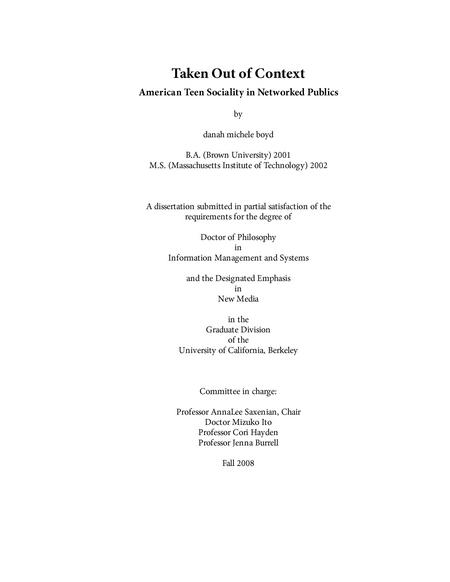
Taken Out of Context: American Teen Sociality in Networked Publics
This dissertation documents author's 2.5-year ethnographic study of American teens' engagement with social network sites.
Tag(s): Hackers and Computer Philosophy
Publication date: 01 Jan 2008
ISBN-10: n/a
ISBN-13: n/a
Paperback: 406 pages
Views: 15,600
Type: Thesis
Publisher: n/a
License: Creative Commons Attribution-NonCommercial-NoDerivs 3.0 Unported
Post time: 24 Mar 2009 03:08:02
Taken Out of Context: American Teen Sociality in Networked Publics
 This dissertation documents author's 2.5-year ethnographic study of American teens' engagement with social network sites.
This dissertation documents author's 2.5-year ethnographic study of American teens' engagement with social network sites.
Publication date: 01 Jan 2008
ISBN-10: n/a
ISBN-13: n/a
Paperback: 406 pages
Views: 15,600
Document Type: Thesis
Publisher: n/a
License: Creative Commons Attribution-NonCommercial-NoDerivs 3.0 Unported
Post time: 24 Mar 2009 03:08:02
Share — copy and redistribute the material in any medium or format
The licensor cannot revoke these freedoms as long as you follow the license terms.
Click here to read the full license.
Danah Michele Boyd wrote:As social network sites like MySpace and Facebook emerged, American teenagers began adopting them as spaces to mark identity and socialize with peers. Teens leveraged these sites for a wide array of everyday social practices—gossiping, flirting, joking around, sharing information, and simply hanging out. While social network sites were predominantly used by teens as a peer-based social outlet, the unchartered nature of these sites generated fear among adults. This dissertation documents my 2.5-year ethnographic study of American teens' engagement with social network sites and the ways in which their participation supported and complicated three practices—self-presentation, peer sociality, and negotiating adult society.
My analysis centers on how social network sites can be understood as networked publics which are simultaneously (1) the space constructed through networked technologies and (2) the imagined community that emerges as a result of the intersection of people, technology, and practice. Networked publics support many of the same practices as unmediated publics, but their structural differences often inflect practices in unique ways. Four properties—persistence, searchability, replicability, and scalability—and three dynamics—invisible audiences, collapsed contexts, and the blurring of public and private—are examined and woven throughout the discussion.
While teenagers primarily leverage social network sites to engage in common practices, the properties of these sites configured their practices and teens were forced to contend with the resultant dynamics. Often, in doing so, they reworked the technology for their purposes. As teenagers learned to navigate social network sites, they developed potent strategies for managing the complexities of and social awkwardness incurred by these sites. Their strategies reveal how new forms of social media are incorporated into everyday life, complicating some practices and reinforcing others. New technologies reshape public life, but teens' engagement also reconfigures the technology itself.
Tweet
About The Author(s)
Danah Boyd is a Principal Researcher at Microsoft Research and the founder of Data & Society. She's also a Visiting Professor at New York University's Interactive Telecommunications Program. Her research examines the intersection between technology and society.

Danah Boyd is a Principal Researcher at Microsoft Research and the founder of Data & Society. She's also a Visiting Professor at New York University's Interactive Telecommunications Program. Her research examines the intersection between technology and society.